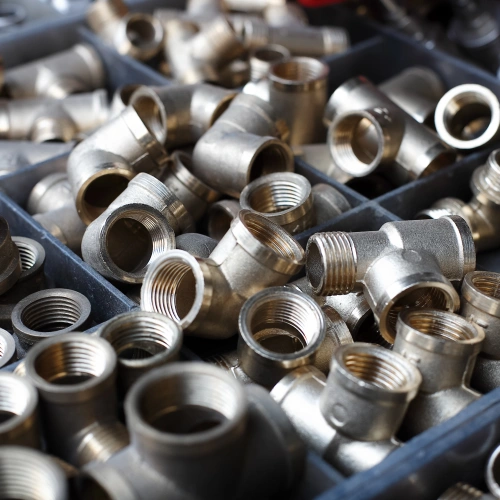Welded vs. Threaded Pipe Fittings: Which is Better?
Pipe fittings are essential components in various industries, from plumbing and construction to oil and gas. They connect different sections of pipe, helping to redirect flow, change direction, or adjust pipe sizes. Two popular types of pipe fittings are welded and threaded fittings, each offering distinct advantages depending on the project requirements.
In this article, we’ll explore the differences between welded and threaded pipe fittings, weigh their pros and cons, and help you determine which is best suited for your specific needs.

Overview of Welded Pipe Fittings
Welded pipe fittings are joined to pipes through a welding process. This process involves fusing the edges of the pipe and fitting together using heat and pressure. Welded fittings are known for their strength and reliability, making them ideal for high-pressure and high-temperature systems.
Materials: Welded fittings are commonly made from materials like carbon steel, stainless steel, and alloys designed to withstand harsh conditions.
Applications: They are typically used in industries like oil and gas, chemical processing, power generation, and in systems where pressure and temperature exceed the capacity of threaded fittings.
Pros of Welded Pipe Fittings:
Durability and Strength: Welded connections are incredibly strong and can withstand high pressure and stress.
Leak Prevention: A well-executed weld creates a leak-proof joint, ensuring system integrity over time.
Longer Lifespan: Welded joints are highly resistant to corrosion and wear, which extends the life of the system.
Cons of Welded Pipe Fittings:
Labor-Intensive Installation: Welding requires specialized equipment and skilled technicians, which can increase labor costs.
Higher Upfront Costs: The materials and labor involved in welding make it more expensive compared to threaded fittings.
Permanent Joints: Once welded, the connection cannot be easily disassembled for maintenance or repairs without cutting the pipe.
Overview of Threaded Pipe Fittings
Threaded pipe fittings, as the name suggests, use threads to connect pipes. These fittings are simply screwed into place and can be easily removed or replaced when needed, which makes them a popular choice for DIY and temporary installations.
Materials: Threaded fittings are commonly made from steel, brass, and plastic, with materials selected based on the intended application.
Applications: Threaded fittings are widely used in residential plumbing, low-pressure systems, and industrial applications where ease of installation is a priority.
Pros of Threaded Pipe Fittings:
Easy and Quick Installation: Threaded fittings can be quickly installed without the need for special equipment, making them cost-effective for smaller projects.
Reusability: Threaded connections can be unscrewed and reused, which is beneficial in maintenance or repairs.
Lower Initial Costs: The materials and installation process are less expensive compared to welded fittings.
Cons of Threaded Pipe Fittings:
Prone to Leaks: Over time, threaded connections can loosen due to vibrations or pressure, potentially leading to leaks.
Limited Pressure and Temperature Resistance: Threaded fittings are not suitable for high-pressure or high-temperature systems, where welded fittings perform better.
Less Durable: Threaded joints are more prone to wear and damage, especially under extreme conditions.
Welded vs. Threaded Pipe Fittings: Key Differences
When comparing welded and threaded pipe fittings, several factors must be considered, including strength, cost, installation ease, and suitability for specific applications.
Strength and Durability: Welded fittings provide a more durable and robust connection. They are ideal for systems under high pressure and temperature, such as in the oil and gas industry. In contrast, threaded fittings are less durable, especially in systems with high vibration or pressure.
Leak Prevention: Welded fittings create a secure, leak-proof joint, while threaded fittings are more prone to leakage, particularly in high-pressure systems where the threads can degrade over time.
Installation: Threaded fittings are simpler and quicker to install, requiring only a wrench to tighten. Welded fittings, on the other hand, require more specialized tools and skilled labor, making them more time-consuming and expensive to install.
Cost: Threaded fittings are generally more affordable due to their simpler installation and materials. Welded fittings, while more expensive upfront, offer better long-term value, especially in demanding applications.
Applications: Welded fittings are ideal for heavy-duty, high-pressure applications like those found in industrial systems. Threaded fittings, however, are well-suited for low-pressure systems or projects requiring flexibility and easy disassembly, such as residential plumbing or temporary installations.
When to Use Welded Pipe Fittings
Welded pipe fittings are most beneficial when your system requires high strength, durability, and leak resistance. Common situations where welded fittings are preferable include:
High-Pressure and High-Temperature Systems: Welded joints can handle the demands of systems operating under extreme conditions, such as in chemical processing plants, oil and gas pipelines, and power generation systems.
Permanent Installations: For systems that require long-term reliability and are unlikely to require disassembly, welded fittings provide a permanent, secure solution.
Corrosive Environments: Welded fittings are ideal in corrosive environments where the integrity of the connection is critical to system safety and performance.
When to Use Threaded Pipe Fittings
Threaded pipe fittings are an excellent choice when ease of installation, cost, and flexibility are more important than strength. They are best used in the following scenarios:
Low-Pressure Systems: Threaded fittings are suitable for systems with lower pressure requirements, such as household plumbing or HVAC systems.
Temporary Installations: Threaded connections are ideal when a system may need to be disassembled or replaced in the future. They’re also perfect for applications requiring frequent maintenance or modification.
Smaller Projects: For smaller projects or DIY work, threaded fittings are often the more practical choice due to their ease of use and lower initial costs.
Both welded and threaded pipe fittings have their place in various industries. Welded fittings offer unmatched strength, durability, and reliability, making them ideal for high-pressure, high-temperature, and permanent installations. On the other hand, threaded fittings are a cost-effective and easy-to-install solution for low-pressure systems, temporary setups, and smaller projects.
Ultimately, the choice between welded and threaded fittings comes down to your project’s specific needs. If your project demands a strong, long-lasting connection, welded fittings are likely the better choice. However, for simpler, low-cost, and reusable connections, threaded fittings may be more suitable.
